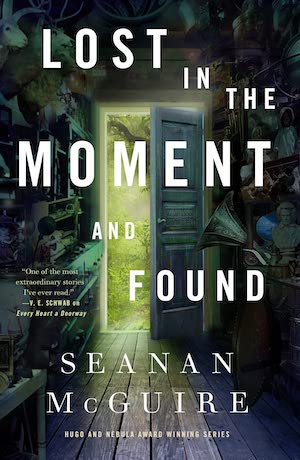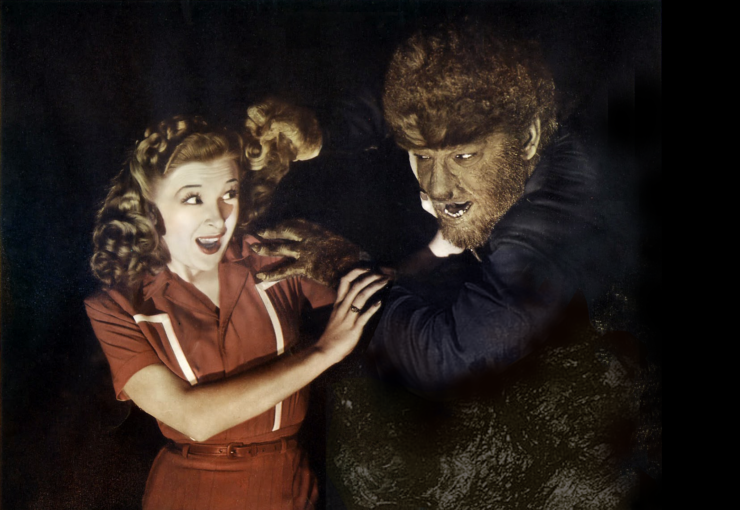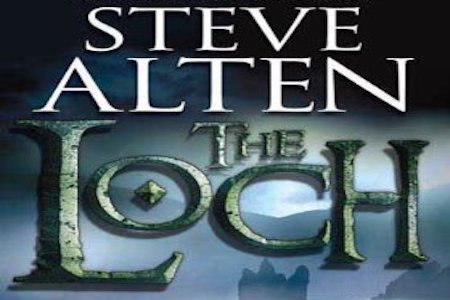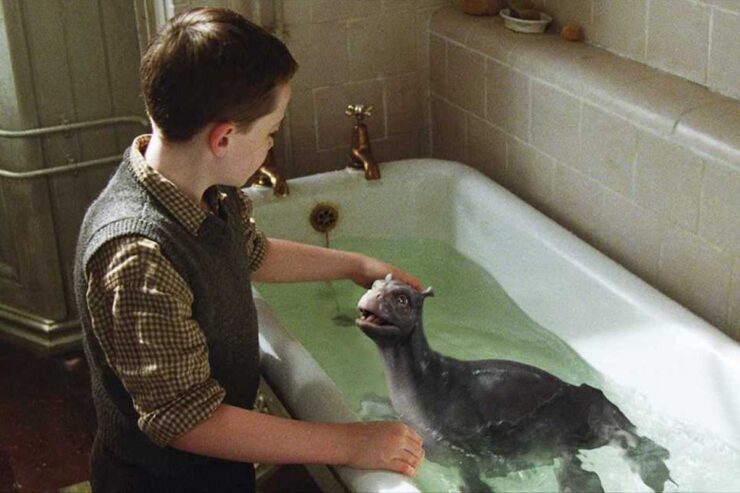In my introductory post to this chapter of the SFF Bestiary, commenters observed that there is no iconic source for the werewolf in modern folklore. Bram Stoker’s Dracula presents the image of the vampire on which subsequent versions would build, or deconstruct depending on the author’s inclination. For the werewolf, there is no such classic text.
There may be no literary model, but there is an iconic original in film. The Wolf Man (1941) stars Lon Chaney Jr. in a smallish gem of a tale, written by Curt Siodmak, about a young man, a curse, and the tragedy that ensues. There’s a pretty girl, a claustrophobic little village attached to a centuries-old castle, and a Roma family that happens to travel through just as the wolfbane is in bloom.
The film opens with a direct pointer to its theme: an excerpt from an encyclopedia that describes the effects of a werewolf curse on the village attached to Talbot Castle. We then see the arrival of Larry, the heir to Talbot Castle now that his elder brother has died. A hunting accident, supposedly. It’s taken at face value, but considering what happens in the film, one wonders.
Larry has been abroad for almost twenty years, living the life of the younger son who does not expect to inherit. His return is voluntary; he and his father get along decently well, and he receives a warm and sincere welcome.
Larry has been making a living as an optical engineer, working on, among other things, the Mount Wilson Observatory in California. His father, Sir John, is an illustrious astronomer, the kind of gentleman scholar who used to be quite the done thing in British academia. Larry helps install a new part in the family telescope; while testing it, he spies on a beautiful woman who lives above the local antique shop.
Larry being a red-blooded male in his prime immediately sallies into town and makes moves on the girl. She fends him off with practiced good humor. He looks around for a purchase to justify his presence in the shop, and settles on an unusual cane topped with a silver wolf.
While he and the lovely Gwen become acquainted, a Roma caravan arrives in town. The story moves fairly quickly then. Larry insists on taking Gwen out that evening. Gwen, wise to the ways of young men, enlists a chaperone, her friend Jenny. They sally forth to visit the Roma and get their fortunes told.
It’s a dark and foggy night, and the woods are deep and mysterious—even more so in black and white. By this time we’ve had a couple of infodumps of werewolf lore, and heard these lines recited twice:
Even a man who is pure of heart and says his prayers by night,
May become a wolf when the wolfbane blooms and the autumn moon is bright.
It’s Jenny who speaks them this time, upon encountering a patch of wolfbane. Once they reach the camp, Jenny goes in first to see the fortuneteller, a man named Bela—played by none other than Bela Lugosi. He sees a five-pointed star in her palm, and reacts both strongly and strangely.
Buy the Book


Lost in the Moment and Found
Then the horse in the camp starts to fidget. And the fog thickens. And a wolf attacks Jenny.
Larry kills the wolf with his cane, but the wolf bites him. In 1941, we might not have realized what that means, but by 2022, we know exactly what just happened. It’s too late for Jenny, and for Bela the werewolf—and for Larry, though his fate will take some time to unfold.
The story advances with stark inevitability. Sir John and the local authorities try to track down the wolf who supposedly killed Jenny and Bela, though town gossip spreads the truth, that Larry committed the latter killing. Larry gradually succumbs to the werewolf curse, proving the truth of the legend: that a man bitten by a werewolf will become one, and that the werewolf will see a pentagram in the palm of his next victim, and finally that only silver, or a silver bullet, can kill him.
Bela’s mother, Maleva, frames the story with bits of Roma wisdom and werewolf lore. She comes to the village mortuary not to pray over the body of Bela, but to speak a sort of spell:
The way you walked was thorny, through no fault of your own. But as the rain enters the soil, the river enters the sea, so tears run to a predestined end. Your suffering is over, Bela my son. Now you may find peace.
She will say the same words at the end, after the rest of the plot has wound to its conclusion. In the meantime the authorities continue to track the wolf. And Larry continues to devolve into a wolf-human hybrid.
He confesses all to his father, but Sir John refuses to believe him. Sir John is a man of the modern world, and in that world, men don’t literally transform into wolves. This must be a mental disorder, he declares, and brings in a learned doctor to psychoanalyze his son.
Larry knows all too well that there is no modern or scientific cure for what ails him. His curse is literal and physical, and it’s getting harder to resist. He goes to Gwen to tell her he is leaving the village, and sees the star in her hand. He runs from her, but he can’t escape the village, or the curse.
Sir John finds him as he attacks Gwen, and does to him what he did to Bela, with the same silver-handled cane. Only after Larry is dead, when he transforms back into a man, does Sir John realize what he has done. Maleva appears and speaks the incantation/invocation/words of comfort over the body.
It’s a tragic story, with the rhythms and resonance of one of the darker fairy tales. The constantly repeated snippets of lore, the poems and incantations, the young nobleman and the beautiful girl and the wise old witch-woman, the curse and its fated outcome, go all the way back past Ovid and his Metamorphoses, into the roots of the oldest of old stories.
The main element that’s become canon since this film aired is the connection of the werewolf curse with the full moon. Here there’s a reference to the bright moonlight, but the timing doesn’t get any more specific. It’s more clearly tied to the growing season of the wolfsbane plant, also known as aconite: so essentially any moonlit night between midsummer and first frost. The rest of the year, presumably, the victim is safe from the curse.
It’s a nice film, not too horribly dated, aside from the use of an ethnic slur for the Roma. Larry comes across as a creeper when he spies on Gwen and then makes moves on her, but he’s forthright about his spying and she gives as good as she gets. There’s more than a hint of man as predator here; it’s also clear that the woman knows it and has a good set of defenses. When she starts to yield to his charms—despite being engaged to marry the local gamekeeper, an arrangement more of convenience and proximity than passion—she’s aware of what she’s doing, and she keeps a solid degree of control.
It’s not until Larry is fully under the influence of the curse that he violates her consent. He pays for it with his life—tragically, at the hand of his own father. And that has resonances, too, because one of the things Sir John reminds his son is that the lord of the manor is responsible to and for the people of the town. They’re his people. He looks after them and protects them. When the heir succumbs to the curse, the lord does what he has to do.
Bela the Roma fortuneteller transforms fully into a wolf. Larry the aristocrat only goes halfway, turning into a very hairy but still humanoid creature. The brown man becomes all animal. The white man gets to keep some of his humanity. It gives the star a chance to use his acting skills while in heavy makeup, something he couldn’t do if he had a wolf (or more like a large, trained dog) as a body double. But it also has an air of systemic racism.
The other thing that’s less actively problematical but a little hard to overlook is the disconnect between the purportedly English setting and the utterly American look and speech of all the actors. The flattest of flat Middle American vowels might be sort of explainable in Larry who’s spent nearly two decades in California, but Sir John is equally American. So are all the other characters, except the two Roma, with their Eastern European accents.
It’s disconcerting, but this is Hollywood just before the U.S. entered World War II. The actors aren’t putting on fake accents. They’re just talking the way their American audience would be used to hearing people talk. It’s kind of charming in its way.
It’s a good story, in any case, and it’s well done for what it is. Lon Chaney Jr. as the wolf-human hybrid is the prototype of all the versions that followed. Like Boris Karloff as Frankenstein’s monster, he defines the role. He is the Wolfman.
Judith Tarr is a lifelong horse person. She supports her habit by writing works of fantasy and science fiction as well as historical novels, many of which have been published as ebooks. She’s written a primer for writers who want to write about horses: Writing Horses: The Fine Art of Getting It Right. She lives near Tucson, Arizona with a herd of Lipizzans, a clowder of cats, and a blue-eyed dog.














